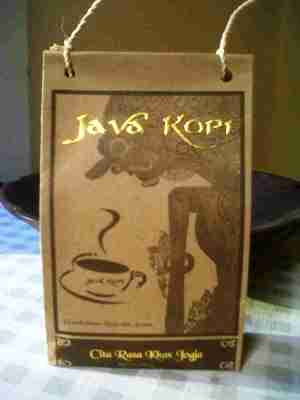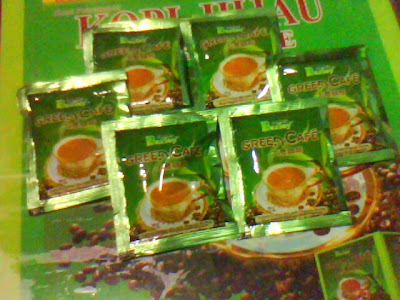luwak coffee
What is kopi luwak?In a recent post I mentioned Kopi Luwak, the coffee that is “processed” in the digestive tract of a civet cat (usually Paradoxurus hermaphroditus). These animals (found in southeast Asia and related to mongooses, although they look and behave a bit like raccoons) eat ripe coffee berries. Stomach enzymes have a subtle but apparently genuine chemical impact on the coffee beans, which are gathered as soon as possible after being passed by the civet, e.g., in the scat.
I mentioned Animal Coffee in my post, a company which specializes in kopi luwak. I soon received a 4-oz sample of luwak beans, as well as a hunk of civet crap in lucite (left), and a brochure, all enclosed in a very attractive gift box, a really nice presentation.
Is this sustainable coffee? I’ll get to a review of the coffee itself, but first let’s try to determine if this is sustainable coffee.






Civets eat mostly ripe fruit and seeds, but also small vertebrates and insects. Since the civets do not eat coffee berries exclusively, luwak-processed beans are not common. They also must be harvested from fresh scat, before rain breaks up the clustered beans/poop. This is because 1) the elements might further change the taste of the beans, 2) the beans would be very hard to find on the forest floor individually, and 3) Animal Coffee, at least, requires the beans to come to them in scat form to be assured they are genuinely luwak-passed. So, the availability of luwak beans is limited; I’ve read that annual production is between 200 to 500 pounds (100 to 250 kilos). Added by Bernardo Diaz
Asian palm civets have a wide range throughout southeast Asia (see map). Because civets do not produce enough volume from any single location, the beans are from a variety of places — even (and probably) different countries. Some beans will be robusta, some arabica, some lots mixed. There is no way, however, to determine if the beans came from a rustic small plot, or a large sun coffee plantation dosed with chemicals.
Civets are arboreal animals, living in trees and raising young in tree cavities. This might indicate that they would require forested areas near the coffee farms where they forage. However, any bunch of trees will generally do, as these animals are quite adapatable to human activities and will live towns and villages.
regions where the asian palm civet is located
Added by Bernardo Diaz
What’s it taste like? The sample I received was labeled robusta from Sumatra. The beans were all shapes and sizes, from the size of a BB to more typically-sized, along with shards and beans misshapen by, perhaps, their arduous intestinal journey. Their variety, a sample shown below, is also a testament to their unrelated origins. The roast was fairly dark, with most beans showing some oil.
kopi bean size
Added by Bernardo Diaz
The smell was unpleasant and discomforting, a burnt rubber/plastic smell. It was vaguely reminiscent of the distinct aroma of other Indonesian coffees, but far more strong and offensive. Musky I might have expected, but this smell was not animal-like it any way. It was just as pronounced and weird when the beans were ground. It brought back memories of opening the door to the garage of my childhood home, where my dad and brother had disassembled a car and had greasy parts all over. Yes, that’s it! This coffee smells like used auto parts.
It tasted no better than it smelled, I’m afraid. We made it in a French press, as is our habit when first tasting a new coffee. Super hot, you were hit by the strong — ghastly — aroma, which battled with the taste. It mattered not who won. It was flat, monodimensional, and just nasty. It became rapidly and progressively worse as it cooled. It was not “crappy” tasting, it just had an overwhelmingly assertive flavor of dirty, burnt rubber gasket. We tasted it next to a fairly generic organic Sumatran, which was like ambrosia in comparison.
On the small chance this was an anomaly, we made it again, this time in the Eva Cafe Solo, and served it to more people, including some that were regular diner/pedestrian coffee drinkers. The kopi luwak was consistent, just as aggressively malodorous and grimace-producing as before. One of our most mild-mannered friends announced it was worse than vending machine coffee and declined a second sip. Another was also repulsed by it, and later wrote to me: “After three light sips, I was lost and confused. Was this from a cat’s rectum or a cat’s litterbox? I soon realized, it didn’t matter….” Star[bucks]ling agreed it reminded him of a Jiffy Lube, and found it undrinkable as it cooled.
Asian Palm Civet
Added by Bernardo Diaz
It’s possible, I suppose, that some batches can be good, some bad, since there isn’t enough of it to be sourced from one place. And having been shipped directly from Indonesia, which takes 7 to 10 days to the U.S., it was also not that fresh. You can order green beans, and perhaps they’d be better.
Still, it is really hard to understand how even the freshest luwak coffee could overcome the shortcomings we experienced. It might drinkable, but it has way too far to go to become outstanding or worthy of the price it commands. The chemical changes that take place in the digestive system of the civet are subtle — primarily, proteins are leached out. Proteins in coffee cause bitterness, but bitterness wasn’t really this coffee’s problem, so that can’t account for big improvements. Add that to the hodge-podge of beans — grown in various southeast Asian countries/regions on many different farms under different conditions — it’s just a literal crap shoot that you are going to get a great batch of coffee beans. I just can’t imagine that this coffee can in any way compare with a halfway decent bean grown and roasted with care.
The (ahem) bottom line Ten people tried this coffee, more than our usual reviews. Some were not told ahead of time what it was, to prevent bias. I don’t think any of us had high expectations, and peculiar or unextraordinary we could have accepted. This was wicked. None of us got past an ounce or two, which classified it as basically undrinkable. It killed the motmot.
Nor can we recommend it on the basis of sustainability. There is no way to guarantee the beans were sustainably grown. On a positive note, you won’t find another fecal product as attractively gift-boxed as kopi luwak from Animal Coffee.
Here are some other reviews. There are many fans of kopi luwak, but I have to wonder if those who pay top dollar for it have to convince themselves they love it. At any rate, you will note others are also impressed with the service and packaging from Animal Coffee.


































